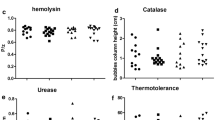Abstract
Seventy-two strains of Microsporum canis, of different origins, were examined from a morphological point of view and tested in relation to their hydrolytic activity on tyrosine, xanthine, casein, gelatin, their ureasic activity and their capacity to assimilate different nitrogenous substances.
The morhological aspects, that vary within the M. canis isolates, were constant in the strains isolated from rabbits.
A strain with particular features was isolated many times from the dogs and cats coming from the same breeder. In one case of pseudomycetoma, different isolates suggested the co-existence in animals of two different strains, one present on fur, the other responsible for deep lesions.
Similar content being viewed by others
References
BadilletG., PietriniP., DavidV. and PanagiotidouD. (1980): Polymorphisme clinique et biologique de Microsporum canis - Bull. Soc. Francaise Mycologie Med. 9: 209–214.
HazenE.L., GordonM.A. and ReedF.C. (1970): Laboratory identification of pathogenic fungi simplified - 3nd ed. Charles C. Thomas - Springfield.
Hopsu-HavuV.K., SonckC.E. and TunnelaE. (1972): Production of elastase by pathogenic and non pathogenic fungi - Mykosen 15: 105–110.
Hopsu-HavuV. K and TunnelaE. (1975): Production of elastase, urease and sulphatase by Ephidermophyton floccosum (Harz) Langeron et Milochevitch (1930) - Mykosen 20: 91–96.
JohnstoneK.I. and LaToucheC.J. (1956): Cultural characteristic of disgonic strains of Microsporum canis Bodin - Trans. Brit. Mycol. Soc. 39: 442–448.
NobreG. and ViegasM.P. (1972): Lipolytic activity of dermatophytes - Mycopathol. Mycol. Appl. 46: 319–323.
PhilpotC.M. (1977): The use of nutritional tests for the differentiation of dermatophytes - Sabouradia 15: 141–150.
RipponJ.W. (1967): Extracellular collagenases from Trichophyton soudanense - J. Bacteriol. 95: 43–46.
RipponJ.W. and VaradiD. (1968): The elastases of pathogenic fungi and actinomycetes - J. Invest. Dermatol. 50: 54–58.
WeitzmanI. and RosenthalS. (1983/1984): Studies in the differentiation between Microsporum ferrugineum Ota and Trichophyton soudanense Joyeux -Mycopathologia 84: 95–101.
Author information
Authors and Affiliations
Rights and permissions
About this article
Cite this article
Morganti, L., Tampieri, M.P., Galuppi, R. et al. Morphological and biochemical variability of Microsporum canis strains. Eur J Epidemiol 8, 340–345 (1992). https://doi.org/10.1007/BF00158565
Issue Date:
DOI: https://doi.org/10.1007/BF00158565




